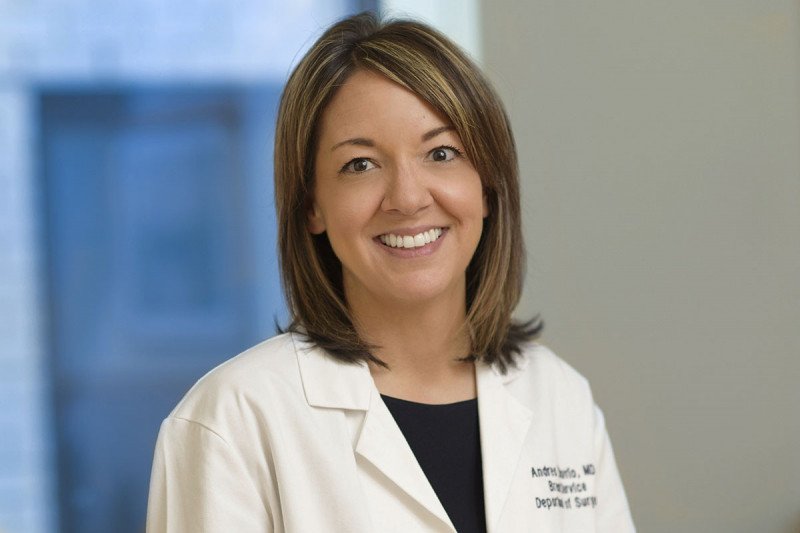
MSK surgeon Andrea Barrio says that even though DCIS is noninvasive and not life-threatening, surgery is nearly always recommended to treat the disease.
Is DCIS a type of cancer?
This is actually a controversial topic, partly due to the language. It has the word “carcinoma” in the name, and it is classified as stage 0 cancer. DCIS refers to abnormal cells that are confined to the milk ducts. These cells have not yet spread into the surrounding normal breast tissue and cannot spread elsewhere in the body. It’s more of a precancer, or preinvasive lesion. So DCIS isn’t life-threatening, but it has the potential to become invasive cancer.
How is DCIS detected and diagnosed?
Most DCIS is detected from a mammogram that shows abnormal calcifications (small deposits of calcium) in the breast. The doctor may need to conduct additional imaging tests, such as ultrasound or MRI. These are used to determine the full extent of the disease.
DCIS is diagnosed by a needle biopsy. Pathologists examine the abnormal cells to determine the grade of the DCIS and the hormone-receptor status. DCIS is classified as low, intermediate, or high grade, depending on how abnormal the cells look under a microscope. High-grade DCIS cells are the most abnormal and grow the fastest.
Hormone-receptor status refers to whether the cancer cells have receptors for estrogen, progesterone, or both. The presence of these receptors on the DCIS suggests that these hormones fuel the growth of the cells, which affects how well the DCIS responds to certain hormone-blocking drugs.
If someone has DCIS, what should be the first step in deciding on treatment?
A person diagnosed with DCIS usually meets with a breast surgeon first. The doctor will assess the tumor’s size, grade, and hormone-receptor status, as well as other risk factors that are important for treatment decisions. For example, should a patient get genetic testing for inherited mutations such as BRCA1 or BRCA2, which are known to raise risk for future breast cancer? Do they have a strong family history of the disease?
What’s the most effective treatment for DCIS?
Surgery is typically the first treatment for DCIS, and it is very effective. There are two types of surgery used for DCIS. The less-invasive option is a lumpectomy, in which a surgeon removes the area of DCIS as well as a little bit of the normal tissue around it, also referred to as a margin. The other option is a mastectomy, which involves removing the entire breast.
Most people with DCIS undergo a lumpectomy, possibly followed by additional treatments. In some cases, a mastectomy is recommended, especially if the DCIS covers a large area or appears in multiple spots throughout the breast. With either of these surgeries, the survival rate is excellent. Our job is to figure out which type of surgery is best for each patient.
Is surgery always necessary for DCIS?
We almost always recommend surgery. Even though DCIS is noninvasive and not life-threatening, it has the potential to turn into something more serious. When we do surgery for DCIS, 20% of the time we find an invasive cancer in the tissue that we did not know about from the needle biopsy. For this reason, the only time we don’t do surgery for DCIS is when we think the risks of the surgery don’t outweigh the benefits. For example, some patients might not be able to tolerate the procedure because of their age or other health problems.
After surgery, what other treatments might be needed?
For those who have a mastectomy for DCIS, there is usually no need for additional treatment because the risk of the cancer coming back (recurring) is very low. After a lumpectomy, there is still a risk that the DCIS may come back or become invasive cancer. To reduce this risk, the two main treatments are radiation therapy and, if the DCIS cells have the estrogen receptor, hormone therapy. These hormone-blocking drugs include tamoxifen, which blocks the estrogen receptor, and aromatase inhibitors, which block estrogen production.
Probably the hardest decision faced by people with DCIS is whether to have one of these additional treatments after a lumpectomy. A lot of factors must be considered, including the size and grade of the DCIS, how close the DCIS cells were to the final margin, and the age of the person at diagnosis. Younger patients tend to have a higher risk of recurrence compared to older individuals. And then as a doctor, I need to consider how each of my patients thinks about risk. For example, a 10% risk of recurrence in the next ten years can mean completely different things to two different people. Some patients want to do everything to lower their risk, while others are happy to just have it watched closely.
What are some advantages of receiving treatment for DCIS at MSK?
At MSK, we have a very thoughtful approach to personalizing treatment for each person with DCIS. The doctors and patients make treatment decisions as a team. Much of the research determining risk factors for DCIS-related recurrence was done at MSK, and we have a computerized prediction model that can help calculate an individual’s risk of recurrence, which helps us decide what treatments are best. We’ve tried to figure out who really needs additional treatments, such as radiation or hormone therapy, and who may be able to avoid certain treatments. Our goal is to find the right treatment for each patient, so that they can remain cancer free with an excellent quality of life moving forward.

